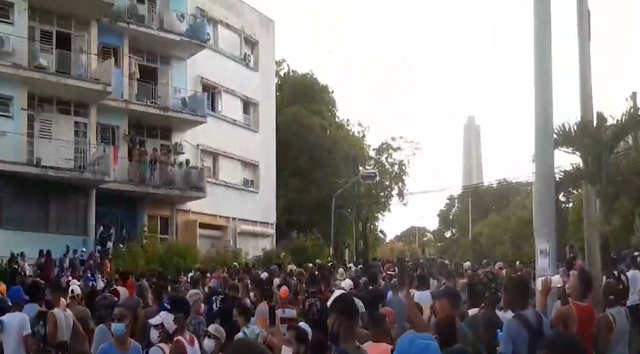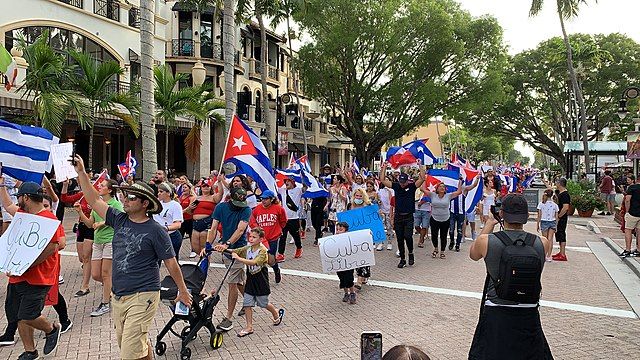“¡Libertad!” “¡Abajo la dictadura!” “¡Patria y vida!” Whether on the streets of Matanzas, Santiago de Cuba, San Antonio de los Baños, or Havana, these chants rang across the island on Sunday, July 11, 2021. Through protests not seen on such a scale for decades, Cubans sought to voice their concerns about the direction of their economy, access to necessities, and the actions of an unresponsive dictatorship. What followed were clashes with the police, and peaceful demonstrators—often those who joined spontaneously—were beaten by police, dragged to prison, while their families were left in the dark for weeks. Protesters who escaped were clouded by the fear of state police watching them, with families getting harassed by authorities and activists forced into house arrest, prisons, or exile. What has followed in the roughly year since the 11J (11 de Julio) protests have been a renewed stranglehold on Cuba’s political ecosystem. What spurred this crackdown, and what does it mean for the future?
What Happened on a Sunny Sunday
The 11J protests are believed to have begun in San Antonio de los Baños and spread to over fifty cities across every province. This was the largest demonstration in Cuba since the 1994 maleconazo protest. It is estimated that 100,000 to 500,000 of the island’s 11.1 million people took part, a small number but high proportion with the government’s repression of civic life.
These protests were precordinated, with Cuban individuals and organizations on and off the island spreading rallying calls. At the lead were Cuban artists, especially from Movimiento San Ysidro, such as Luis Manuel Otero Alcántra, as well as external organizations, including the Miami-based Cubadecide. People on the island amplified the plans for protests from these figures and each other. Cuban authorities arrested hundreds of these people, and thousands more spent weeks in hiding for peacefully protesting.
With the arrests of 1,481 people, including 57 minors subsequent to the demonstrations, chaos and fear quickly consumed households across the island.
Families of detainees reported not receiving information on captured relatives, such as location or reason for detention, or if they were detained at all. Authorities sought out those not detained at the 11J protests, especially those dubbed “instigators”—people with any sort of criminal history, even if unrelated. Police surveilled reporters, artists, and anti-government activists, arresting them if they left their homes.

Why Cubans Took to the Streets
In recent years, the people of the island have found themselves at the intersection of multiple crises, only worsened by the pandemic, left festering under the repression of the government. Already lagging, the Cuban economy and government management has left many without money to spend and resources to survive. Cubans have faced a scarcity of food, with shelves of government-owned supermarkets desolate in recent years. This is worsened by the increasing barriers to obtaining money that the government has put up, such as restrictions on foreign currency, including money received from family overseas that many Cubans rely on. Accompanying this barrier is inflation of the Cuban peso, taking the island from early on in the pandemic.
The pandemic highlighted the scarcity of medicine and care in Cuba. Across the island, death roamed as the medical system was overwhelmed and quickly depleted, without the resources or infrastructure to prepare for COVID-19. Under these circumstances, the small island faced relatively high death rates, with rural and poor urban areas facing the brunt of the illness and loss on the island. Exact figures are hard to pinpoint with the opacity of the government on the island.
These factors, combined with an inactive, complacent government seemed to push people to the edge. Lacking any method of recourse to the government, they took to social media, following a trend of increasing social media use by Cubans. However, this use is still novel, leaving it one of a scarce few of forums not surveyed closely by authorities ready to wipe out dissent. With this, Cubans were able to discuss their own experiences, share in their suffering, discuss wishes of change, and organize plans to push for it.
The Regime Responds
The response from the government was swift. On the day of the protests and after, it is reported that authorities arrested 1,481 people in relation to 11J.
As of June 2022, the number of those still in prison is believed to be 701 people.
Quick to cut off the oxygen supply to the flames of protest, the government caused rolling power outages and internet blockages across the country on July 11 and the days after. With this, the spread of protest information was limited to what had already been shared in just a few hours, and connection to independent press and the outside world was stifled. Laws such as the Telecommunicator Decree Law 35 and Resolution 105, passed in August of last year, enacted new e-communication and cybersecurity regulations, increasing state control over the civil apparatus, restricting a forum that had previously escaped the government’s stranglehold on civic and personal spaces.
In the physical world, many have been imprisoned or exiled in the year since the protests. Relatives of detained persons, including minors, were not aware of their family’s whereabouts for weeks. These people were swept up into Cuba’s legal system, where, in the year since, evidence has been found of physical and psychological torture, unfair trials, and sentences for peaceful protesting lasting anywhere from months to decades. Almost 300 people have been sentenced to prison, including 36 with sedition, with prison sentences up to 25 years. Some detainees include artists responsible for “Patria y Vida,” the song whose title became a rallying cry for the demonstrators. Luis Manuel Otero Alcántara was sentenced to five years, Maykel “El Osorbo” Castillo received a nine year sentence, and Eliexer “El Funky” Marquez Duany was held under house arrest by authorities.
Cubans are also leaving the island in record numbers, but emigration is not always by choice—many have been told by authorities they must choose between prison and exile.
Evidence of this rise in departures can be seen in how many arrivals the United States records from Cuba. In the first five months of 2022, 118,000 Cubans reached the southern border of the US, compared to around 17,400 people in the same period last year, just months before the protests. From October 2021 to July 2022, 3,000 people were intercepted trying to reach the United States by sea from Cuba. These rates of emigration are at some of the highest since Fidel Castro’s ascension to power, surpassing numbers seen during the Mariel boatlift of 1980, fueled by changes in Nicaraguan visa policies, making it a landing point for many Cubans from the island to start their journey northward.
Some are leaving because they were told to, with authorities telling them directly that they either leave the island or go to prison. For others, this comes after weeks of harassment and intimidation by authorities towards themselves and family, suddenly at a loss of work, housing, and safety. Some leave simply because they do not see a future for themselves on the island, with an untenable economic situation that seems unlikely to change. Many of them end up in the United States, unable to work because of legal status in the country, living with family and friends who had already made it off the island.
On the protest and subsequent government actions, Cuban President Miguel Díaz-Canel encouraged Cuban supporters of the government to take to the streets and “act,” seen as the government greenlighting any retribution against protestors, furthered by his saying Cubans would fight to death to defend Castro’s revolution. State propaganda labeled protestors as criminals, vandals, enemies of the state, and claimed that protests were organized by international far-right groups. This has been found to be false.
Under the weight of this renewed repression, anti-government groups and movements, such as Archipiélago and Movimiento San Ysidro, still exist, yet are severely depleted after arrests, exodus, and the fear following 11J.
In the Context of the International
From many foreign governments and international human rights groups came statements of condemnation of the Cuban government’s actions and words of support for the protesters. Many of these governmental statements came from Western democracies, most notably and vocally the United States, a leader of the anti-regime axis. However, many countries remained wary of sending material aid, as most would end up as governmental property, unsure if it would aid the people or regime more. Most independent businesses on the island are small, making overseas aid gifts difficult, so foreign nations are left to balance aiding Cuban people while trying not to do favors for a repressive government.
To draw out an increased response, there have been overseas protests as well, most coming in the weeks following 11J. However, these find most of their participants in descendants of exiles overseas, and have little impact beyond those circles. Many of these have been in heavily Cuban areas of Spain, as well as the United States, such as Miami, Florida, its surrounding areas, and cities in Hudson County, New Jersey.

As time stretched away from 11J, the Summit of the Americas approached, the first time the United States had to face direct diplomacy with the regime. With this, the United States barred Cuba, along with Venezuela, from the summit due to the repression and human rights abuses of each nation.
The United States instead invited Cuban civil society activists to attend for the nation, but Cuban authorities blocked them from flying to Los Angeles.
In response to the Cuban and Venezuelan governments’ absence, President Andrés Manuel López Obrador of Mexico stated that his nation will also not attend. This followed weeks of him declaring Mexico would not attend unless every nation in the Americas received an invitation. The Summit continued, with a notable absence of a powerful Latin American nation in Mexico.
The Summit’s attendance list—and those willingly not on it—seems to suggest a collapse of the anti-regime hegemony led by the United States, with Cuba gaining allies at a time of massive geopolitical shift. Both Russia and China are attempting to build axes of power to combat the United States and Western democracies, and Cuba seems one degree of separation away from them, growing closer each year. Further, Mexico’s moves to assert itself as an alternate powerhouse in the Western Hemisphere, positioning itself with Cuba, signals that more and more countries may be warming to repression.
The Biden Administration seems to be shifting back towards Obama-era policies, lifting some travel restrictions enacted by President Trump. In doing so, the United States is balancing aiding the Cuban economy and people through stimulation and enriching the regime. However, it remains to be seen how this policy shift might continue and change as more Cubans arrive in the United States, growing Cuban-American interests, which often align against any interaction with the island’s government.
Lessons from the Year Since 11J
The response from the international community, a clear, diplomatic rebuke of the regime’s actions, signals that many Western democracies will continue to do what they’ve done–disapprove from a distance. The possibility of a shift seems to come more so from powers in Latin America and Eurasia. With the actions of Mexico and Venezuela, it seems Cuba can strengthen and gain powerful allies in the Western Hemisphere, weakening the US-led wall of diplomacy against it. With the volatile nature of Latin American politics, more nations in the region adopting left-wing leaders, one wonders if opportunities for relationships will increase. If not, will Cuba join the power structures that China and Russia are building? If so, Cuba will only lose interest in enhancing human and political rights domestically.
It seems that this is already happening. Yunior Garcia and Archipiélago planned a follow-up protest for November 15, 2021, dubbed 15N online. The day before the march, Garcia’s home was blocked off by authorities, and he was put under house arrest reminiscent of post-11J detainment. Others known to the government as 11J participants suffered the same home-bound fate that day, and some of the march’s leaders discouraged protesting because of safety concerns. Garcia eventually fled from Cuba to Madrid. Coming months after 11J, the diplomatic response of the international community doesn’t seem to have slowed down the repression of the regime.
Instead, as the suppression economic depression on the island continues, Cuba is losing its youth, especially those most motivated. Not seeing a likelihood of improvement–economically or politically–in Cuba, they are fleeing to Spain, Nicaragua, and the United States, and with them some of Cuba’s hope of a better future. It seems this will continue, only increasing dissatisfaction on the island.
11J and the time since highlighted how this dissatisfaction, across all areas and facets of Cuban life, can turn the island into a powder keg of emotion using the internet and social media. It seems the next frontier of control for the regime will be social media, which they have already shown their might in through blackouts of electricity and internet, as well as criminal punishment for online activism. Will it remain a relatively free forum for the people, or will the government gain a new way of surveillance and control?
Looking Forward
On the surface, much of Cuba seems the same as it did on July 10, 2021. If anything, the lack of resources seems to be more severe, the repression more stifling, and the future bleaker than before. However, just below the surface of today is the renewed dream of a brighter destiny for Cuba, the hope of a politically free future, the future so many got a glimpse of for just hours, just minutes, on a summer Sunday last year. The lasting impact for the island seems to be more repression accompanied by parallel growth in anti-government sentiment and desire for action; Will another explosive moment come, better organized for change next time?





